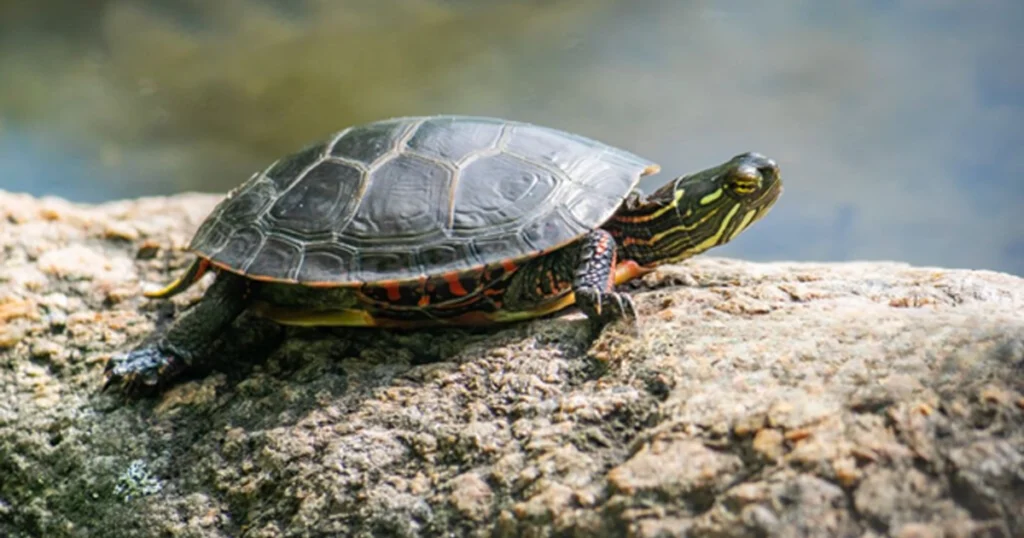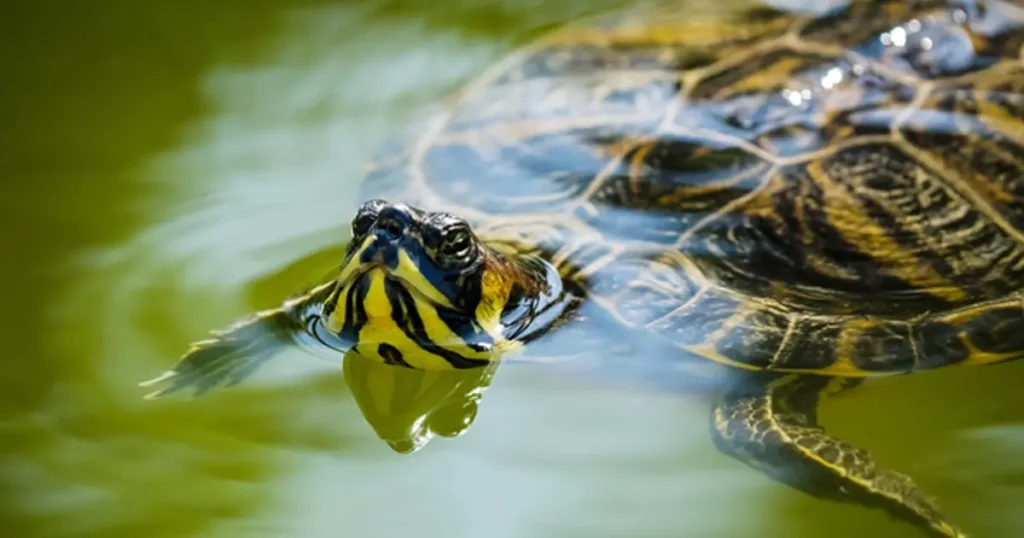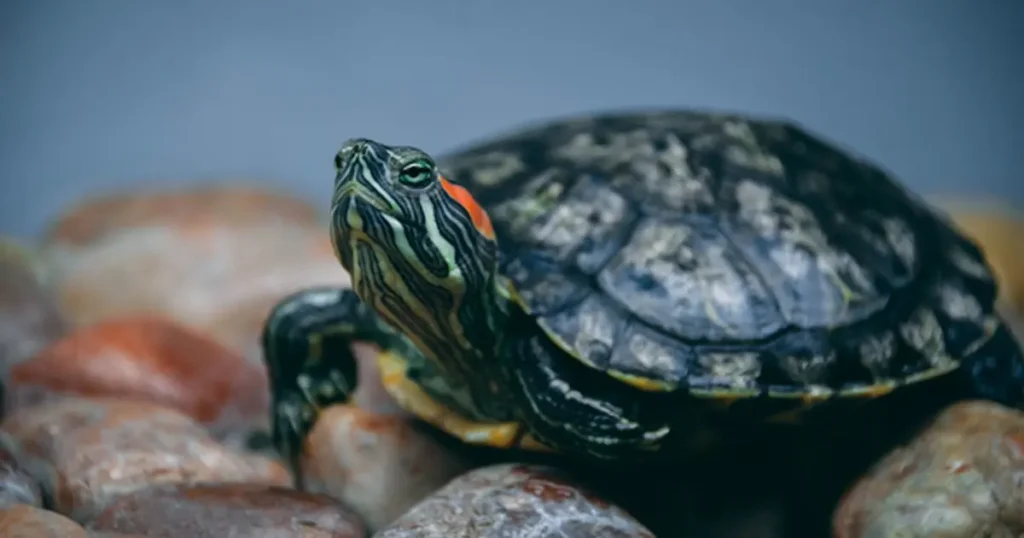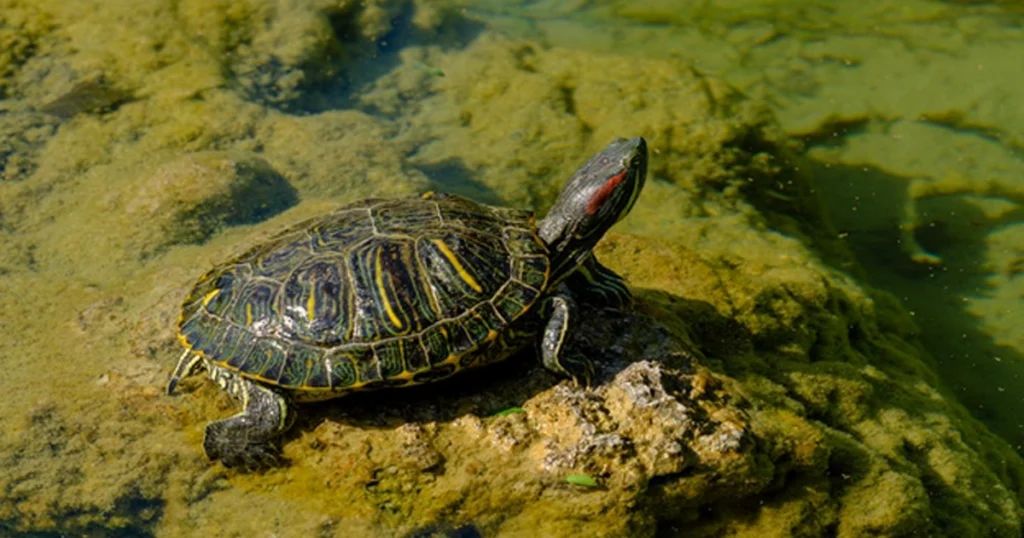Thinking of inviting a new friend into your home? Perhaps a little one with a shell? Cumberland slider turtles might just be what you’re looking for! But, Cumberland slider turtle care is essential if you own them as a pet. These fantastic little creatures are also known as Cumberland river turtles or Cumberland terrapins. These semi-aquatic freshwater turtles are a subspecies of Pond sliders, which originated from the Cumberland River in North America.
These fantastic creatures are known for their vibrant red markings and friendly demeanor. Due to their appearance and nature, Cumberland slider turtles are popular pets. But here’s the deal: taking care of them is exciting and rewarding. In this guide, we’ll explore Cumberland slider turtle care. We’ll cover everything you need to know about keeping your Cumberland slider healthy and happy.

Cumberland Slider Turtle Care: Eating Habits/Diet
So, what do Cumberland slider turtles eat? Cumberland sliders are omnivorous turtles, which means they eat both plant- and animal-based foods. Their diet varies depending on their age and specific nutritional needs. For your Cumberland slider turtle care you should be well aware of their eating diet.
Juvenile Diet
Young or baby Cumberland Slider Turtles eat a lot of protein. They like to eat mealworms, crickets, and tiny insects to get enough protein they need.
Adult Diet
Adult Cumberland Sliders mostly eat plants. They like to munch on green veggies like lettuce, spinach, and plants that grow in water. Eating lots of vegetables keeps them healthy and strong.
Recommended Foods
Vegetables: Overall, the recommended food for Cumberland Sliders is various green foods like collard greens, turnip greens, romaine lettuce, and spinach. They also like duckweed, dandelion leaves, and other water plants.
Animal Proteins: For your Cumberland Slider Turtle care, you can feed them animal proteins like krill, shrimp, bloodworms, fish, water snails, locusts, crickets, and earthworms.
Commercial Turtle Food: Cumberland Sliders can benefit from well-rounded diets such as ReptoMin Food Sticks. These food sticks provide the turtles with nutrition to stay healthy and strong. They serve as a suitable addition to their regular diet.
Avoid Certain Foods
Freeze-Dried Foods: Freeze-dried crickets and shrimp may not offer enough nutritional benefits for Cumberland Sliders. These foods lack essential nutrients that are necessary for their health and well-being.
Seafood and Feeder Fish: Sometimes, certain foods like seafood and feeder fish might have something called ‘thiaminase.’ If Cumberland Sliders eat this regularly, it can create health problems for them. So, it’s good to be cautious about offering these types of foods to your turtle too often.
Supplements
Added calcium and vitamin supplements are important to keep the turtle’s diet well-balanced. A good source of calcium is cuttlefish bone, which you can give after removing the hard backing.
Remember, Cumberland Sliders feed exclusively on water, so ensure their food is available within their aquatic habitat. Now we know, what do Cumberland slider turtles eat? Let’s dive into their feeding schedule.

Feeding Routine for Cumberland Slider Turtle Care
Cumberland slider turtle care requires a balanced diet with a proper feeding routine to ensure they grow well and remain healthy. Here’s a guide to their feeding schedule:
Younger Turtles (Under Six Months): Feed baby Cumberland slider turtles once a day. You can provide a mix of commercial pellets and protein-rich foods such as worms, crickets, and small fish.
Turtles Six Months and Older: Introduce green leafy vegetables like lettuce into their diet and reduce feedings to every other day. Overfeeding, especially with high-protein foods, can cause health issues.
Adulthood: Adjust the feeding schedule to two to three times a week. Balance their diet and don’t overfeed them. Watch out for signs of overheating, such as shell deformities or concentric rings on their shells.
Read More: The Ultimate Guide To Pink Belly Sideneck Turtle Care and Species Profile
Cumberland slider turtle habitat Requirements
Cumberland Slider Turtles have specific needs for their living environment. Here are essential aspects to consider for the Cumberland slider turtle habitat:
Living Space
Baby Cumberland slider turtles can live comfortably in a standard 10 or 20-gallon tank, providing enough room for their size. However, as they grow into adulthood (reach Cumberland slider turtle full size), these turtles need a significantly larger area to accommodate their size and activities. For a pair of adult Cumberland Sliders to move, swim, and bask freely, a spacious 75-gallon filtered aquarium is recommended. This large environment ensures their well-being and allows them to exhibit their natural behaviors without feeling cramped or confined.
Bedding
You might want to use reptile sand or fine pea gravel as the flooring for Cumberland slider turtle habitat. Ensure that the gravel you use is not tiny or too small. Your turtle can swallow small gravel, which may have health consequences.
Basking Area
The Cumberland slider turtle habitat needs a large enough habitat to swim and bask comfortably. Create a separate dry area where your turtle can completely dry off and soak up warmth from a basking light. Heat and UVB light are essential for the Cumberland slider turtle to survive. There are a lot of things you can do to provide turtles with basking areas, like rock slabs or commercially designed areas above water.
Temperature and Lighting
Keep the water between 70-75°F and create a warm basking area at 90°F. Make sure there’s a cool spot in the tank for temperature balance. This helps your turtle stay comfortable and healthy.
Filtration and Water Quality
Set up a good water filter system to keep the water clean for your turtles. Also, use a suitable heating system to maintain water temperatures. Make sure the water is at least 15 inches deep (400 mm) for a comfortable Cumberland slider turtle habitat environment.

Health Concerns for Cumberland Slider Turtle Care
Cumberland slider turtles, like all pets, can face health problems. Some common issues include vitamin A deficiency and metabolic bone disease. Signs of an unhealthy turtle might be wounds, mouth problems, refusal to eat, eye infections, or being lethargic. If your turtle has cuts or wounds, cleaning them with solutions like Betadine can help.
It’s important to note that these turtles may carry salmonella. So ensure you wash your hands thoroughly before and after handling them and use separate utensils. If you observe any health issues, consult a vet specializing in reptiles for guidance and treatment.
Shedding Concerns For Cumberland Slider Turtle Care
Turtles naturally shed their shells, which shows they are healthy. Many newbie pet owners become worried about the shedding issue. The truth is it’s a natural process and a healthy sign.
But if you notice your turtle shedding excess skin, it could signal a problem. Too much skin shedding might mean your turtle is sick. This can happen if they eat too much. You should check their diet and feeding schedule to ensure they eat the right amount.
Read More: A Comprehensive Guide To Reeves Turtle Care & Species Profile
Cumberland Slider Turtles Behavior
Cumberland Slider Turtles are known for their amiable nature and endearing behaviors. They are quite sociable and adapt well to human interaction. These turtles tend to be comfortable handling and may even enjoy it. However, if they get scared, they hurry into the water or hide inside their shells. Because of their quick-moving nature, they’re called “slider” turtles.
These popular pets are active and entertaining to watch. When basking, they might participate in this activity together, sometimes even stacking themselves. Having more than one Cumberland slider can create an enjoyable and lively environment. Whether lounging in the basking spot or diving for food, these turtles create an engaging atmosphere in their habitat.
Cumberland Slider Turtles Size
How big do Cumberland slider turtles get? Cumberland slider turtle full size typically grows to lengths of 11.4 Inches and weighs around 1.31 to 4.84 pounds (596 to 2199 grams). However, it’s crucial to note that selling or buying turtles as pets with a carapace (shell) length of less than 4 inches is illegal in certain regions. In order to ensure baby Cumberland slider turtles‘ well-being, this rule protects them and their populations.
Cumberland Slider Turtle’s Appearance
Cumberland Sliders have a unique appearance with distinctive features. Their shell, which is a bit curved, shows rounded projections at the back. As baby Cumberland slider turtles grow older, their shells become wrinkled, shaped like an oval, and slightly raised. The bottom part of their shell called the plastron, is smaller and doesn’t have a hinge, unlike some other turtles.
Male Cumberland Sliders have longer front claws than females. Females are larger and have rounder shells. Baby sliders look like adults but have green shells and yellow undersides. Their skin is brown with olive-green tones and yellow stripes. They’ve got yellow-to-red bars near their eyes and dark spots on their bellies. Front legs show bright yellow stripes, and behind their eyes, a yellow-orange stripe fades into a deeper orange-red by their neck.

Breeding Behavior & Lifespan of Cumberland Slider Turtles
Cumberland slider turtles breed during winter, spring, and fall. Females lay 6 to 15 eggs per clutch, often laying two clutches annually. Females may nest far from water, sometimes encountering roads and cars. Approximately 71% of females lay two clutches a year, and clutch sizes range from six to 15 eggs. Cumberland sliders have a lifespan of 20 to 40 years.
Read More: 8 Best Types Of Pet Turtles
Wrapping Up
Well, that wraps up our chat about these amazing Cumberland Slider Turtle care! Remember, taking care of these buddies isn’t just a responsibility. It’s a wonderful journey filled with learning and fun. From their cozy habitats to their meal plans, these turtles need our attention and love.
Keep in mind that they’re not just pets; they will become a part of your family. So, keep those tanks clean and their meals balanced, and cherish every moment spent with your lovely Cumberland Slider Turtle pals!
